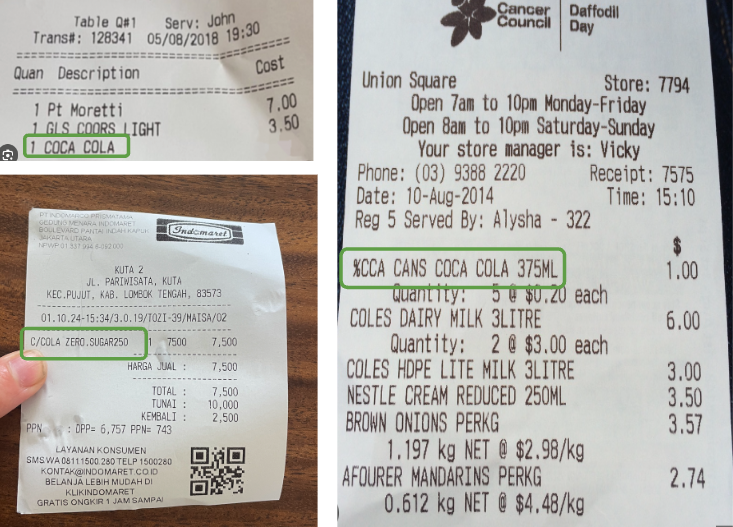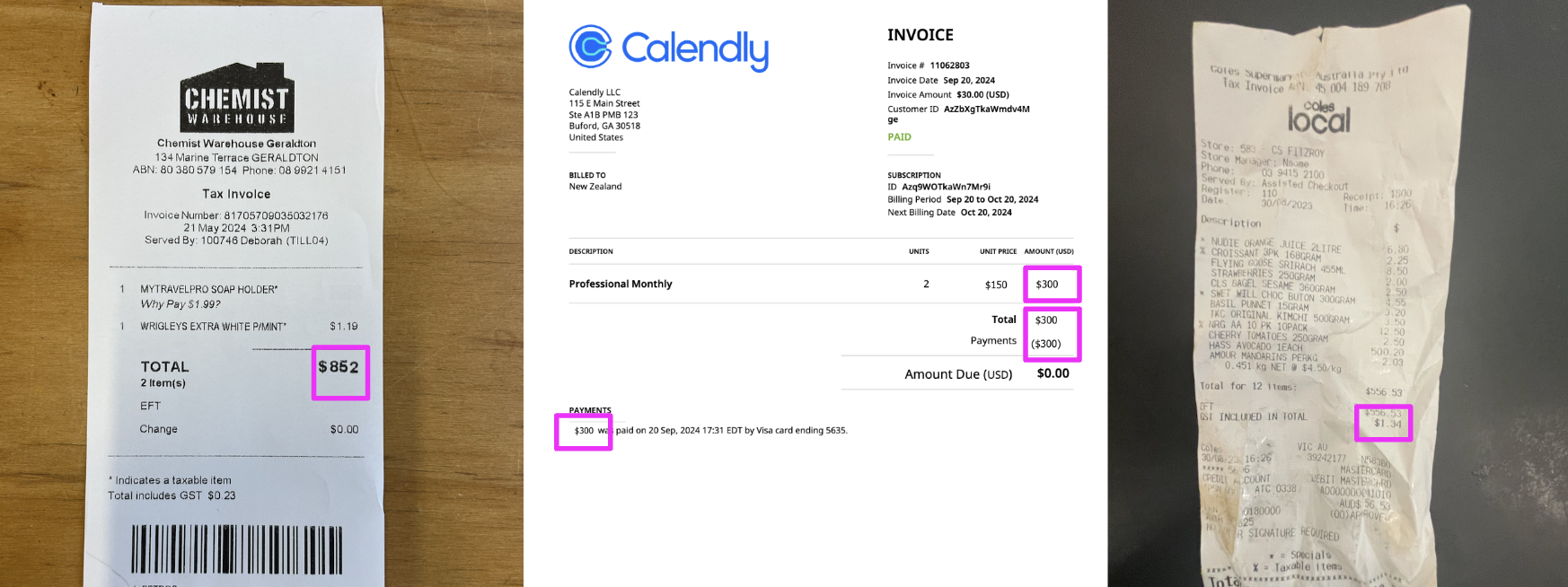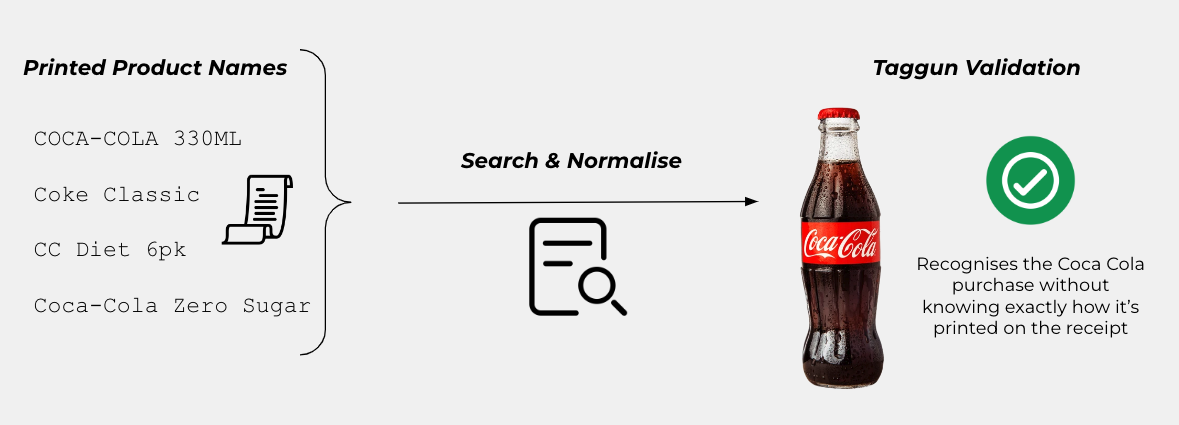Receipt Validation Fundamentals
Brands running D2C rewards promotions often face challenges validating purchases across multiple channels.
Taggun’s system simplifies this by enabling seamless receipt validation across various retailers and channels.
This page outlines the key principles of receipt validation and addresses challenges like product identification and fraud detection.
What is Campaign-Based Receipt Validation?
Campaign-based receipt validation is the process of verifying receipts submitted by customers to determine their eligibility for rewards or promotions. It involves checking if the receipt meets predefined campaign criteria, such as specific product purchases, purchase dates, or total spend amounts.
Key Components
- Receipt Data Extraction: Capturing essential information from submitted receipts
- Data Normalisation: Standardising information such as product descriptions, store names, model numbers, and dates to ensure consistency across different receipt formats.
- Criteria Matching: Comparing extracted data against campaign rules
- Reward Eligibility Determination: Deciding if the purchase qualifies for the campaign offer
- Fraud Prevention: Ensuring the authenticity of submitted receipts
Example
A beverage company might run a promotion where customers who purchase two qualifying products from any U.S. retailer are entered into a draw to win Theme Park tickets. This requires validating that the customer’s receipt includes the correct products.


The Campaign Validation Process
- Document Upload:
- Customers upload a photo of their receipt or invoice through your campaign interface.
- Data Extraction:
- Taggun's engine extracts key information from the receipt.
- Intelligent Validation:
- Taggun's system standardises information like product names, store names, dates, receipt formats, and currencies to ensure consistency.
- It checks if the receipt meets your campaign’s rules.
- Fraud Detection:
- Advanced algorithms detect potential fraud, such as duplicate receipts or altered images.
- Validation Result:
- A boolean result (true/false) is generated.
- A detailed response explains the reasons for validation success or failure.
- Reward, Reject, or Review:
- Upon successful validation, users can be rewarded.
- If the validation fails, you can:
- Prompt the user to correct and resubmit the receipt.
- Automatically reject the submission.
- Flag the receipt for manual review if needed.

Basic Campaign Validation Flow
Key Challenges in Receipt Validation in Promotions
1. Brand and Product Identification Variability
A major challenge in receipt validation is the inconsistent way brands and products are described across different sales channels:
- Varied Point of Sale (POS) systems in retail stores
- Different formats in e-commerce platforms and D2C channels
- Inconsistent brand representations and product naming conventions
For example, in a Coca-Cola promotion across retail and D2C channels, entries might appear as:
- "COCA-COLA 330ML" (airport)
- "Coke Classic" (local convenience store)
- "CC Diet 6pk" (Walmart)
- "Coca-Cola Zero Sugar" (D2C website)

This variability makes it challenging to accurately identify qualifying brands and products across all purchase points.
2. Fraud Detection and Prevention
Rewards promotions are attractive targets for fraudulent activities because frauds may attempt to game the system for personal gain. Common types of fraud include:
- Duplicate submissions of the same receipt
- Digitally altered receipts (e.g., using photo editing software)
- Creation of fake receipts or order confirmations
- Submission of old receipts or orders from outside the promotion period
Detecting these fraudulent attempts while ensuring a smooth experience for genuine customers is crucial for maintaining campaign integrity.

3. Slow Setup and Inflexible Criteria
Many rewards programs struggle with slow setup and inflexible rules. This makes it hard to create unique, engaging promotions. Systems that can't handle complex criteria limit what brands can offer, often resulting in less exciting campaigns for customers.
Additionally, long setup times and slow, non-real-time validation processes can seriously damage the customer experience. When customers have to wait to know if they've earned a reward, it reduces the excitement and immediacy of the promotion, diminishing the crucial "wow factor" that keeps them engaged.
How Taggun Addresses These Challenges
Tackling Brand, Product and Store Name Variability
-
Advanced Natural Language Processing (NLP):
- Taggun has developed context-aware AI technology to understand brand and product descriptions across various formats.
- It recognises variations, abbreviations, and even misspellings of brand names and products.
-
Continuous Adaptation:
- Taggun models continuously learn from diverse receipt and order confirmation formats across retail and D2C channels.
- This allows for accurate brand and product identification even when faced with new or unusual descriptions.
-
Customisable Brand and Product Mapping:
- Clients can provide lists of expected brand names, product variations, and their D2C equivalents.
- Taggun's engine uses these mappings to improve accuracy for specific campaign brands and products.

Robust Fraud Detection
Taggun offers a suite of fraud detection tools as a fundamental part of its receipt validation system. Having built-in fraud prevention is crucial for maintaining the integrity of your campaigns, ensuring that only genuine purchases are rewarded.
These tools help detect duplicate submissions, digitally altered receipts, and other suspicious activity, protecting your promotions from misuse while providing a seamless experience for legitimate customers.
By integrating fraud detection into the validation process, you can safeguard your campaigns and uphold trust in your brand.
Discover more about Taggun Fraud Detection here.
SmartValidate
Taggun’s SmartValidate feature allows you to easily set up campaign rules using a dynamic, natural language prompt. This flexibility means you can get creative with your campaign criteria while keeping the setup process simple and intuitive.
For example, you could create a campaign with the Smart Validate setting:
"Validate receipts where the customer buys at least two qualifying products, and ensure the purchase was made using a credit card or mobile payment."
With SmartValidate, crafting custom campaign rules is straightforward, giving you the freedom to run unique and engaging promotions with minimal effort.
Discover more about Taggun Smart Validate here
Benefits of Taggun's Campaign Receipt Validation
- Accurate Brand, Product, and Store Matching: Easily validate purchases across both retail and D2C channels.
- Fraud Prevention: Protect your campaign from fraudulent submissions across all channels.
- Scalability: Efficiently manage large, multi-channel promotions with reliable accuracy.
- Better Customer Experience: Real-time rewards for legitimate participants, no matter where they shop.
- Data Insights: Access valuable data on purchasing trends and campaign performance across all channels.
Conclusion
Taggun’s receipt validation system tackles the key challenges of modern promotions and D2C initiatives. By addressing variations in brand and product identification and offering robust fraud detection, we provide a reliable and efficient solution for campaign managers. Our technology ensures smooth, secure promotions, rewarding genuine customers while preventing fraud.
Note For Expense Management
While Taggun’s technology is designed for promotions, we are also exploring solutions for expense management receipt validation. If you have specific needs in this area, please reach out to our team at [email protected]. We would love to learn about your needs and explore expanding the support.
Updated 11 months ago